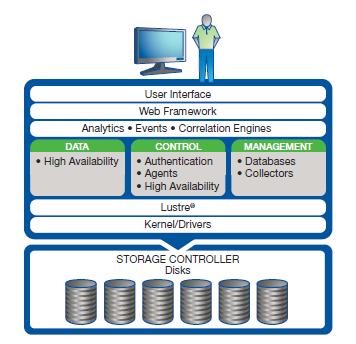Terascala TeraOS V5.4 for Availability
For HPC hardware monitoring and scalability with Lustre
This is a Press Release edited by StorageNewsletter.com on December 25, 2014 at 2:26 pmTerascala, Inc. announced that it has released a version of its product, TeraOS v5.4, that manages data, performance, and reliability for Lustre-based storage appliances.
It has integrated hardware monitoring and analytics that are aggregated to a single pane of glass for operational transparency. Unlike competing solutions, TeraOS has purpose built sensors to monitor all the major system components such as servers, storage controllers, host adapters, disks, network fabric, and cables.
TeraOS incorporates a sensor network with a scalable monitoring framework to read these sensors in near real time. It correlates the returned metrics and provides health status and alerts on major components, as well as a time-series performance analysis. Without all-inclusive hardware monitoring and drill-down dashboard reporting, competitors and their customers must rely on a collection of tools and time consuming log file sifting to determine the root cause of degraded performance or component failures.
Enterprise customers and leading research universities have voiced strong opinions on the high value of TeraOS in their HPC environment.
“We have deployed nearly 3PB of TerasOS managed Lustre storage as part of our HiPerGator supercomputer. It would be very difficult to manage that scale of storage and complexity without the comprehensive and integrated hardware monitoring that TeraOS provides,” commented Dr. Erik Deumens, director of research computing, University of Florida.
“Our users expect our HPC capabilities to be always available with no degradation in performance. The monitoring that TeraOS provides covers everything in the storage appliance aggregated to a single health metric. If we have a problem, we can drill down. And if we need support, there is one company, Terascala that supports the entire storage system. This allows a small staff to meet our user’s reliability demands,” observed James Lowey, VP information technology, Translational Genomics Research Institute.
“The TeraOS comprehensive hardware monitoring and reporting are key to administering large scale Lustre installations like BlueRidge,” said Brian Marshall, computational scientist, Virginia Tech Advanced Research Computing. “We can focus on research rather than the intricacies associated with Lustre and all the hardware.“
“Large clusters like Hyades that use a Lustre file system, need hardware monitoring to ensure that it’s always up and running,” noted Shawfeng Dong, director astrophysics and HPC, University of California Santa Cruz. “TeraOS and its intuitive dashboard give us real tim operational status for easy managemen of a complex system.“
“Our customer’s don’t want to spend valuable time looking through log files and tweaking Lustre settings to keep their advanced scientific applications running at peak performance,” remarked Alan Swahn,VP marketing, Terascala. “TeraOS provides the hardware monitoring, performance analytics, and systemwide view they need to make sure there aren’t any bottlenecks.“














 Subscribe to our free daily newsletter
Subscribe to our free daily newsletter

